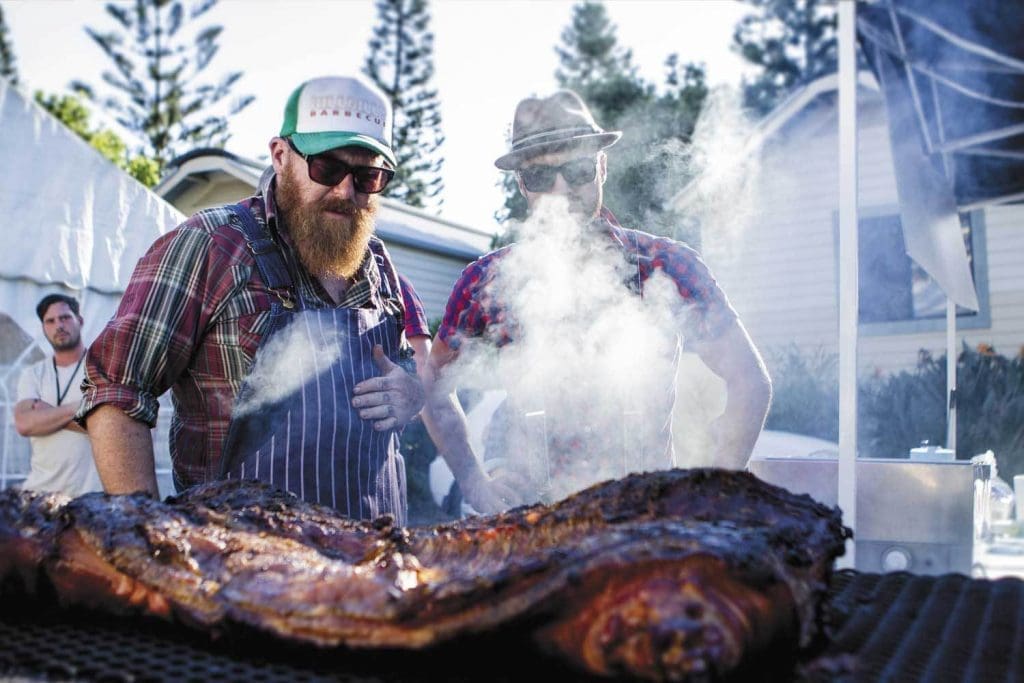
Australia’s own celebrity pitmaster “Hillbilly Wes” from the Bovine and Swine restaurant in Sydney. Picture: Meatstock
AS Australia’s beef export volumes continue to retract sharply, there’s an emerging risk of the domestic beef market becoming swamped by product being diverted out of the international trade – even at a time when slaughter volumes are historically low for this time of year.
The Australian domestic market has become something of a ‘safe-haven’ for red meat processors this year, as export volumes continue to slide dramatically. August volumes to all export markets were down 27pc, year-on-year, while the previous month showed a similar trend, back 23pc on July trade last year.
Countering that, of course, has been equally substantial declines in beef production. Recent eastern states kills have struggled to remain above 100,000 head, about 30pc below this time last year. That’s come as a result of:
- 18 months of sustained drought causing herd liquidation, and lower availability of slaughter-ready cattle, and
- Processing plant closures caused either by COVID control measures, or general shortage of slaughter cattle and lack of profitability in an increasingly competitive export market landscape.
Strongest market in the world
What’s clearly evident, however, is that the domestic beef market has been impacted far less than the export trade this year.
“It is our strongest market in the world at the moment, particularly for certain items,” analyst Simon Quilty told a recent webinar.
Illustrating this, New Zealand beef has over the past month or so been imported into Australia – “simply because of how strong the Australian domestic market has been,” Mr Quilty said. “It’s been arriving in volumes that we haven’t seen in this country for ten years.”
New Zealand is one of only three countries, including Vanuatu and Japan, currently eligible to export beef to Australia.
Traders told Beef Central that while volumes are quite modest, most of the recently-arrived NZ product was made up of cheaper items including frozen trim, knuckles and rounds.
In contrast with exports, the domestic beef market appears to have declined very little in volume, if at all, compared with pre-COVID levels.
Food service utilisation remains somewhat behind pre-COVID volume, but the consistent message from retailers – ranging from national supermarket chains down to small independent butcheries – is that their beef turnover remains well above pre-COVID levels, despite rising prices since March.
One large Sydney retail chain recently told Beef Central that its turnover was still 10-15pc above numbers written this time last year.
A large multi-site beef processor told Beef Central this morning that between 50 and 60 percent of his company’s weekly production was currently staying on-shore. That’s a startling figure, in comparison with typical domestic share around 28-30 percent.
Another reason why more product is being pushed back onto the domestic market is that it avoids the impact of currency in the transaction. Since the start of June, the A$ has risen US6c, or about 9pc against the US$. That’s made Australian exports relatively uncompetitive in export markets which mostly trade in US dollars, helping push more product back into domestic cold stores.
Over-supply prospect looms
The current relative strength of the domestic market for Australian beef, compared with flat demand across North and South Asia and North America, could produce its own challenges, however.
With a potential meat buying audience under 30 million, there is always a ‘tipping point’ where the domestic market can reach over-supply, despite its current strong performance.
A large multi-state domestic wholesaler told Beef Central on Friday that the trade was currently ‘edgy’ about the beef price outlook in the domestic market, with increasing evidence of product being diverted out of traditional export channels.
“Everybody is in the same boat,” he said. “There’s clearly a lot of hesitancy about getting too far forward with stock, because product bought today could start to look expensive by next week – if the inflows of product being diverted out of exports continues to get pushed back into the local trade,” he said.
Price pressure is already being seen, in certain items. Butt cuts, secondary cuts and fattier trims were showing signs of price pressure due to supply, the wholesaler said.
“Nobody is swimming in them yet, but everybody is being pretty conservative,” he said.
Better quality items were holding up better in price, but some cheaper items had already fallen at least a dollar or two per kilo.
“But it’s hard to price items accurately at the moment, because of fluctuations week-to-week, and even day-to-day, due to this extra product being seen, another large wholesale trader said.
“Suffice to say it is currently quite volatile on the domestic beef market scene,” he said.
“Loin meat is still strong, but everything else is slowing up quite dramatically. Better examples of MSA and 100-day grainfed cube rolls were still making $32-$35/kg on Friday, which means by the time they are on the tray in the shop window, that turns it into a $60/kg steak. But that’s the exception,” he said.
Prices like that were pushing customers to cheaper steak items, like striploins or rumps.
While trade into the food service sector was reasonably active, it was at a reduced level compared with pre-COVID, and food service buyers in other states remained wary about a second wave shutdown like that currently being seen in Victoria, in which case they could get caught with stock.
